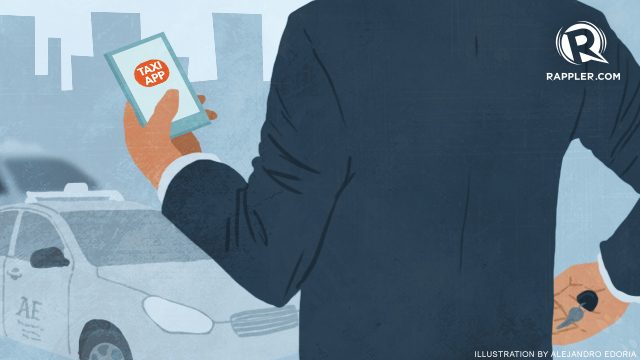SUMMARY
This is AI generated summarization, which may have errors. For context, always refer to the full article.

Three months ago, I decided to stop driving. Things were tight financially and I was getting tired of the daily drive from Bonifacio Global City to Makati. During rush hour, McKinley road slowly leaks cars out on to EDSA like a dirty sieve, and the 90 minutes I’d waste every day traversing the 7-kilometer loop was time I’d never get back.
Ride-sharing vs driving
I imagine I’m right within the target markets of both Uber and GrabTaxi, the Philippines’ two competing ride-sharing services. I live in one densely-populated business district and work in another, own a smartphone with a data plan, and absolutely loathe haggling with cabbies.
The economics of my transition were pretty straightforward. Daily parking in Makati is 180 pesos, my building parking in the Fort was 5,000 per month, and my gas consumption was 1,200 per week. The average month saw about 15,000 in car-related spending, if you didn’t account for the upkeep and insurance costs involved in maintaining a 6-year-old Honda Civic.
Nowadays, I use a ride-sharing service 12 to 15 times a week. The BGC-to-Makati route costs somewhere between 100–140 pesos in moderate traffic, so I save about 7,000 to 8,000 pesos per month by giving up my Civic. Perhaps even more importantly, I gained 90 minutes of productive time daily. Where I previously had to focus on the road, I could now write emails, work on my web apps, watch movies or TV episodes, or just doze off.
Uber vs GrabCar
It’s interesting to watch how Uber and GrabCar (GrabTaxi’s non-taxi brand) have differentiated themselves over the past year. There’s no question that San Francisco-based Uber has the better user-interface and better overall experience. Even against its other US competitors – Lyft and Sidecar — the Uber interface looks professional and reliable. On paper, its origins make it fundamentally ill-suited to hitting the mainstream here in the Philippines however, because it only accepts credit cards as payment. In contrast, the Malaysian GrabTaxi (GrabCar’s parent company) was born in the developing world and, in theory, better understands how to address ASEAN markets where credit card penetration is substantially lacking (only 5% in the Philippines).
These differences affect passengers in interesting ways. Although Uber requires a credit card, it feels cheaper in the long run because drivers never have to make change. Because you’re handing GrabCar drivers cash at the end of each trip, you’re also more likely to just leave change with them, especially when it’s less than 20 pesos. (When you’re taking 60 trips a month, that overage does tend to add up.)

Additionally, it’s not clear to me whether allowing cash transactions differentiates GrabCar to a significant enough degree from its competitor. Ride-sharing services are always going to be upper- and middle-class-only solutions in the developing world, in the same way that Starbucks is a luxury available only to the top two brackets of our population. The people who can afford to spend 300 pesos a day on transportation tend to come from the same 3–5% of the population who are most likely to have credit cards and mobile data plans. No one in the C, D, and E economic brackets can afford to spend over 30% of their household income on transportation – that’s over 90% of the country.
Drivers vs car owners
The effect of this economic gap is interesting when you compare it to the ride-sharing situation in San Francisco. According to my ride history, I took over 3 dozen Ubers while visiting the Bay Area, and in most cases, the driver owned their vehicle. In the Philippines, the majority of Uber and GrabCar drivers are employees of the car’s owners, many of whom are subject to the same “boundary” agreements as regular taxi drivers.
One of my recent GrabCar drivers related a very familiar set of daily requirements from his employer: Once the car had accrued 2,500 pesos in earnings for the day, the driver would earn 90 pesos for each booking above that. In practice, he would make about 500–800 pesos per day over a 10-hour, 18-trip shift. If the 2500-peso minimum isn’t reached however, the driver makes nothing.
The people vs LTFRB
As the government-imposed deadline for Uber’s licensing in the Philippines looms, my transportation situation and the livelihoods of thousands of car owners and drivers hang in the balance. On August 11, the LTFRB has declared that all Uber and GrabCar cars will be apprehended on the road if the service and the operators aren’t properly licensed. (READ: LTFRB to start unregistered Uber, GrabCar clampdown)
I am reminded of the oft-repeated joke that “licensing” is what it’s called when a government “takes away your right to do something and then sells it back to you.” Admittedly it’s a reductive way to look at the situation, but it’s hard to beat such a colourful soundbite.
Under the new licensing plan, platforms like Uber and GrabCar will need to apply to be Transport Network Companies (TNCs), and their individual vehicle operators will have to apply to be franchisees. Both the networks and the individual operators will need to register their businesses with the BIR. Accompanying these announcements was some rhetoric about the government’s continued commitment to public commuter safety, buses-falling-off-skyways and MRTs-crashing-through-barriers notwithstanding. (READ: LTFRB to Uber: No one is above the law)
Uber’s legal status has been questioned a number of times in the 59 countries it currently operates in. In May 2015, Italy banned the UberPop service as being “unfairly competitive.” In June 2015, police arrested the Uber country directors for France and charged them with “enabling taxi-driving by nonprofessional drivers, among other crimes of entrepreneurship.”
The $50B company seems more than capable of defending itself however, as their recent campaign and resulting victory against New York Mayor Bill de Blasio indicates.
On the west coast, meanwhile, there’s an ongoing debate about whether Uber drivers are in fact employees of the company and thus entitled to health insurance and other benefits. To your average Filipino, the notion seems almost quaint — the regular taxi fleet operators here aren’t exactly renowned for giving their drivers any employee benefits.
Innovation vs regulation
At the heart of all this is the notion that traditional industry is being disrupted by technology, and regulation is racing to keep up with innovation. The same thing happened to information and entertainment in the late 90’s and early 2000’s respectively, and is currently happening in the finance sector with the cryptocurrency revolution. There’s no question that ride-sharing solutions are providing compelling alternatives that are both environmentally-friendly and cost-effective, and it’s not clear whether these additional licensing requirements will make our respective Uber or GrabCar rides any safer than they already are. (READ: #CommuterWatch: ‘Choosy’ taxi drivers and other transport woes’)
I don’t relish the idea of going back to driving myself through heavy traffic again every day, even if it were financially viable. Regulating the innovators only serves to equalize the playing field for the incumbents, and does nothing to improve the situation for citizens.
In the absence of ride-sharing options, should we all just go back to bribing cab drivers again? – Rappler.com
Luis Buenaventura is a cofounder at Rebit.ph, a startup providing a cheaper money-transfer solution for the $27B Philippine remittance industry. His writing on Bitcoin and its impact on remittances and mobile money has been featured on Techcrunch, The Next Web, and Tech in Asia.
This piece is originally posted in the author’s blog and was published with permission from the author.
Add a comment
How does this make you feel?
There are no comments yet. Add your comment to start the conversation.